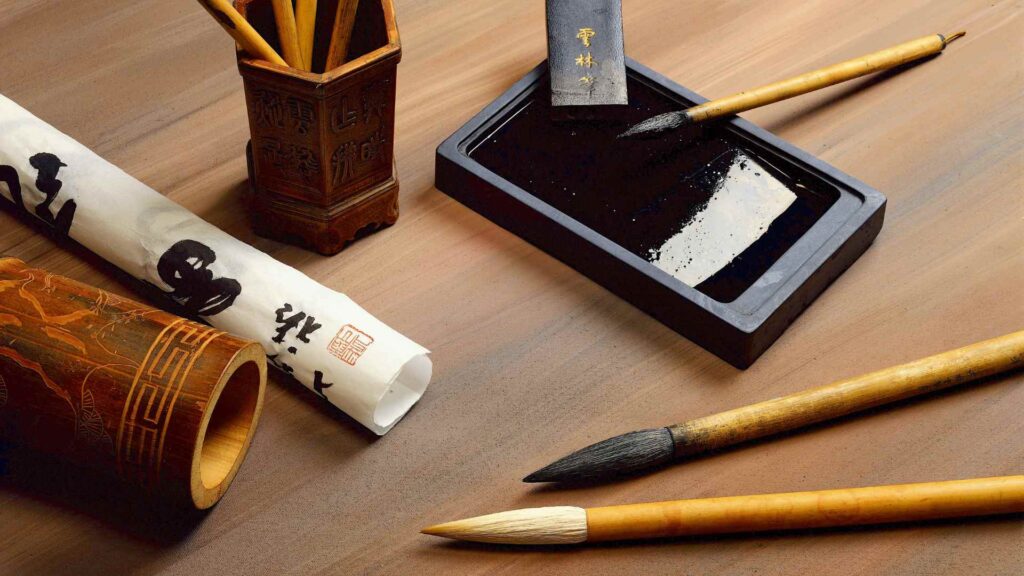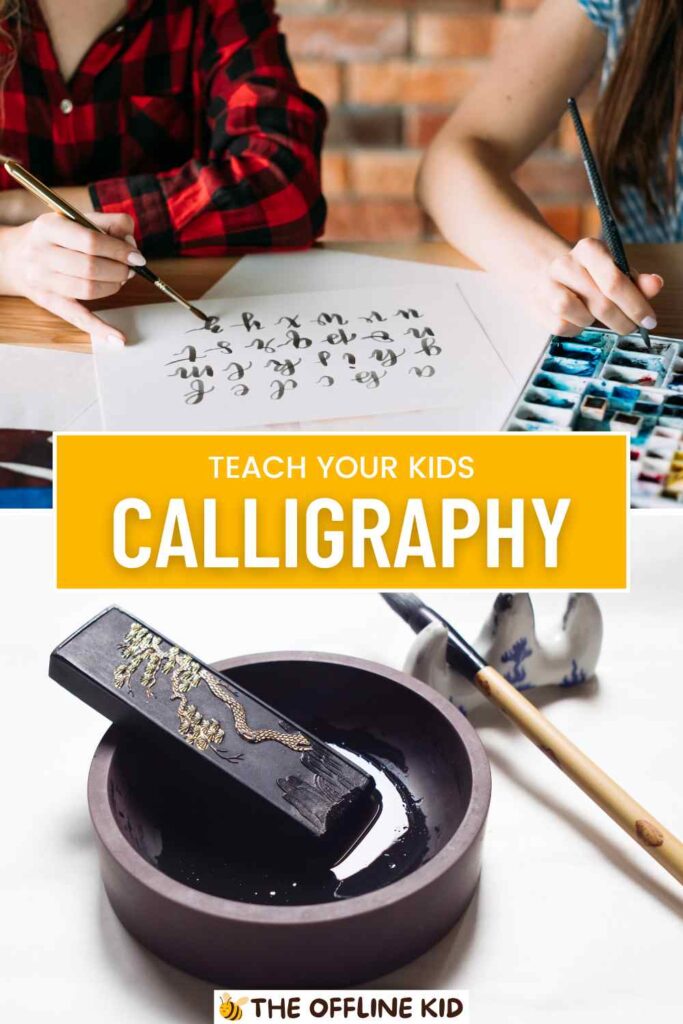Calligraphy isn’t just about pretty letters—it’s an immersive art form that helps children develop patience, discipline, and creativity.
By introducing your child to calligraphy, you’re giving them a hands-on way to explore self-expression, refine motor skills, and boost self-esteem.
This guide will help you inspire your child’s journey into beautiful lettering.
Understanding the Basics of Calligraphy
Calligraphy is the art of decorative handwriting, where each letter is formed with deliberate, graceful strokes.
While modern technology has made typing and texting second nature, calligraphy offers a tangible connection to writing that your child can truly feel.
By learning calligraphy, kids can develop a sense of pride in personal craftsmanship, marvel at the elegance of hand-lettered art, and discover a brand-new avenue for self-expression.

Breaking Down Calligraphy Styles
- Traditional Calligraphy: This style focuses on formal scripts, like Gothic, Italic, or Copperplate, which have structured letterforms and time-tested techniques.
- Modern Calligraphy: Freer and more expressive, modern calligraphy breaks many of the rigid rules of traditional scripts, allowing your child to experiment with quirky letter shapes and strokes.
- Brush Calligraphy: Using markers or brushes, this style is often more forgiving for kids, as it relies on flexible brush tips for thick and thin stroke variations.
Benefits of Learning the Fundamentals
- Hand-Eye Coordination: Slow, purposeful strokes build motor control and hand steadiness.
- Concentration: Focusing on forming letters properly encourages patience and mindfulness.
- Aesthetic Appreciation: By studying and replicating letterforms, children learn to see and appreciate details in art and design.
Tips for Introducing the Basics
- Start Simple: Introduce basic strokes and shapes before diving into full alphabets. These foundational marks teach your child to vary pressure and master the pen’s angle.
- Engaging Practice: Use lined practice sheets or dotted guides to help keep letters uniform.
- Keep It Playful: Encourage your child to explore different styles and create fun letter variations. Use bright colors or swirl patterns to keep practice sessions enjoyable.
Calligraphy gives children an inspiring first step into the world of art by honing fundamental skills that can be applied throughout their creative pursuits.
By understanding what calligraphy truly is and introducing its core elements, you’re equipping them with the tools to succeed on this artistic journey.

Why Calligraphy Is Great for Kids
In a world dominated by fast-paced digital interactions, calligraphy encourages children to slow down, focus, and create something tangible.
This combination of creativity and discipline fosters a sense of achievement and helps kids appreciate the power of craftsmanship. Here’s why introducing calligraphy to your child can be a wonderful investment in their development.
Enhancing Fine Motor Skills
- Precision and Control: Each stroke in calligraphy requires deliberate motion, enhancing fine motor control.
- Grip Refinement: Holding pens or brushes correctly over prolonged periods develops proper posture and grip strength.
- Spatial Awareness: Understanding how letters connect, and how words form on a page, refines spatial reasoning.
Boosting Self-Confidence
- Visible Progress: As your child’s calligraphy grows neater and more stylish over time, they gain satisfaction and a stronger sense of self-accomplishment.
- Personal Expression: Calligraphy lets kids infuse their own personality into every flourish or curve, promoting creative self-discovery.
- Artistic Showcase: Hand-lettered projects, from greeting cards to wall art, become proud keepsakes that reinforce your child’s sense of capability.
Promoting Mindfulness and Patience
- Focused Attention: The art of forming letters slowly and consistently promotes present-moment awareness.
- Calming Effect: Like drawing or painting, calligraphy offers a gentle, almost meditative way to relieve stress and practice emotional regulation.
- Steady Growth: Calligraphy doesn’t yield instant results. Kids learn the value of patience and perseverance, essential life skills for any creative pursuit.
Building a Long-Term Artistic Base
- Gateway to Other Arts: Learning the fundamentals of balanced composition and aesthetic flow can prime children for painting, illustration, and more.
- Color and Design Exploration: Mixing inks, choosing paper, and embellishing scripts fosters an interest in broader design principles.
- Cultural Appreciation: Various cultures have their own calligraphic traditions, and exploring these can expand your child’s worldview and inspire them to experiment.
By combining visual artistry, tactile skill, and patient practice, calligraphy stands out as an ideal way to help kids discover the joy of making something beautiful and meaningful with their own hands.
The Right Tools and Materials
Outfitting your child with the right calligraphy tools is crucial for their comfort, enjoyment, and skill development.
While you don’t need to break the bank on expensive supplies, choosing quality, age-appropriate materials can make all the difference.
Whether you’re focusing on dip pens, brush pens, or regular felt-tip markers, providing the right equipment helps ensure a smoother, frustration-free start.
Choosing the Perfect Writing Instrument
- Dip Pens: Traditional dip pens with nibs come in different shapes and sizes. They help teach control over ink flow but might be tricky for very young children. Start with a nib that isn’t too flexible so your child can focus on consistent strokes without sudden ink splotches.
- Fountain Pens: Modern fountain pens with calligraphy nibs provide a smoother ink flow and are often easier to handle than dip pens. They can be more expensive, though, and require some upkeep.
- Brush Pens: Brush pens are fantastic for beginners because they’re less messy and more forgiving. They also let kids experiment with expressive strokes that vary in thickness based on pressure.
- Markers: Broad or chisel-tip markers can substitute for calligraphy markers. They won’t mimic the exact flow of a traditional nib, but they still help kids practice letterforms without worrying too much about messy ink.
Paper and Practice Sheets
- Smooth Paper: Look for paper specifically designed for calligraphy or marker use to prevent feathering and bleeding.
- Practice Pads: Gridded, dotted, or lined practice sheets guide letter spacing and alignment, making learning easier.
- Scrap Paper: Always keep extra paper on hand for warm-ups or to experiment with new strokes before applying them to a final piece.
Optional Accessories
- Ink Choices: If you opt for dip pens, non-toxic, quick-drying inks in bright colors can spark your child’s interest.
- Pen Holders and Grip Aids: For very young kids, using a pencil grip on pens can ensure they develop proper posture and minimize strain.
- Calligraphy Guides: Printable worksheets, traceable letters, or beginner-friendly calligraphy books can offer structured practice for kids at different ages.
Maintenance and Care
- Cleaning Routines: Teach your child to rinse dip pen nibs or brush pens after each use to extend their lifespan and maintain quality lines.
- Storage Solutions: A tidy desk or container keeps calligraphy pens and supplies organized and within easy reach.
- Refresh and Replace: Frayed brush tips, overused markers, and worn nibs will hamper progress, so be ready to replace them.
By providing the right calligraphy tools, you set the stage for a more enjoyable and productive learning experience.
The ultimate goal is to encourage your child’s sense of exploration and wonder, ensuring that they fall in love with the process rather than feel held back by clumsy, inadequate materials.

Setting Up a Fun Learning Environment
Creating a supportive, inspiring space for calligraphy practice can dramatically boost your child’s motivation.
When kids feel comfortable, curious, and at ease, they’re more likely to explore new ideas and engage in practice sessions wholeheartedly.
Transforming even a corner of your home into a dedicated calligraphy station can build anticipation and excitement for each lesson.
Designating a Workspace
- Pick a Quiet Corner: Reduce distractions by choosing a well-lit, calm area. Natural light is a bonus, as it helps your child see finer details more clearly.
- Organize Supplies: Keep pens, paper, and ink neatly arranged in containers or on a shelf. An organized space reduces setup hassles and makes it easier to jump into practice.
- Comfortable Seating: A stable chair and a desk at the right height encourage good posture and reduce strain on arms and neck.
Incorporating Inspiration
- Visual Displays: Hang samples of calligraphy alphabets, uplifting quotes in beautiful scripts, or your child’s own artworks to inspire them.
- Mood Elements: Encourage focus by using gentle background music, or place a small plant or other decorative items for a pleasant environment.
- Reward Chart: Track progress with stickers or stamps to celebrate milestones—like learning a new letter style or completing a successful project.
Balancing Structure and Freedom
- Scheduled Practice: Setting consistent times for calligraphy practice helps build discipline. Even 15-20 minutes per session, a few times a week, can yield impressive progress.
- Time for Play: Let your child doodle freely with brushes or pens to spark creativity. They might discover new styles or patterns on their own.
- Encourage Exploration: If your child wants to experiment with unusual color combinations or whimsical flourishes, support their curiosity. Mistakes often lead to fresh ideas and breakthroughs.
Practical Tips for a Happy Environment
- Tidy Up Regularly: Encourage your child to clean their workspace after each practice session. This builds responsibility and ensures the area remains inviting.
- Display Achievements: Whether it’s a complete alphabet sheet or a fun doodle, showcasing your child’s work on a bulletin board or refrigerator validates their effort.
- Celebrate Imperfection: Calligraphy is an art of progress—no one is perfect at the start. Let them know that wobbly lines are stepping stones to improvement.
With a thoughtfully arranged workspace that encourages curiosity and creativity, your child will naturally gravitate toward practicing calligraphy. It’s not just about neatness; it’s about creating a positive atmosphere where imagination and discipline can flourish together.
Techniques and Practice Routines
Establishing good technique from the get-go can save your child frustration and bad habits down the line.
While creativity is key, the structured aspect of calligraphy—the angles, the pressures, the rhythm—offers a guiding framework that helps children progress steadily.
Below are some core techniques and practice strategies that you can incorporate into your child’s routine.
Mastering Basic Strokes
- Upright Lines: These are your child’s warm-up exercises. Focus on keeping the pen angle consistent and maintaining steady pressure for uniform thickness.
- Curves and Circles: Have them practice slow, circular motions that help refine control and wrist flexibility.
- Transition Strokes: These strokes move from thick to thin or vice versa. They’re essential in calligraphy for giving letters their characteristic flair.
Developing Pressure Control
- Light Touch vs. Firm Pressure: Brush pens or flexible nibs let kids experiment with line thickness. Explain how varying pressure creates contrast and visual interest.
- Breathing Techniques: Encourage slow, calm breathing while writing. Holding one’s breath can lead to shaky lines, so a gentle exhale helps maintain steadiness.
- Consistent Practice: Repetition solidifies muscle memory. Print out worksheets that feature repetitive practice of common letter shapes, like ovals or loops.
Structured Drills
- Alphabet Drills: Go letter by letter, focusing on letter spacing and uniform size. Reward small accomplishments—like a neatly written row of ‘A’s—to keep morale high.
- Word Practice: After mastering individual letters, let your child try short words. Simple words like “cat,” “dog,” or their own name provide a fun, tangible target.
- Timed Sessions: Set a timer for five to ten minutes of dedicated practice on a specific stroke or letter. Limiting the focus can lead to noticeable improvements quickly.
Beyond the Basics
- Flourishes and Embellishments: Once your child is comfortable with the standard strokes, introduce decorative flourishes. These can be loops, swirls, or ornamental tails that give calligraphy its distinctive flair.
- Color Play: Experiment with colored inks, metallic pens, or watercolors to create vibrant calligraphy pieces. Children love seeing their writing come to life in bold hues.
- Letter Variations: Encourage them to explore different alphabets or create their own stylized letters. This sense of freedom can ignite long-term interest.
Building an Enjoyable Routine
- Warm-Up Ritual: Start each session with hand and wrist stretches to reduce tension.
- Short, Frequent Practice: Instead of long sessions, opt for smaller, more frequent bursts of focused writing to keep your child engaged.
- Use Fun Prompts: Incorporate quotes from their favorite books, motivational phrases, or silly tongue twisters to keep things fresh.
By blending structure with a dash of creativity, you’ll help your child develop steady hands and a keen eye for detail. This balance between disciplined drills and playful experimentation sets the foundation for a rewarding calligraphy journey.
Inspiring Creativity with Projects and Exercises
Simply practicing letters can become monotonous if children don’t get a chance to see how their skills can be used in real-life, creative ways.
Projects and exercises that integrate calligraphy techniques can spark excitement and curiosity, turning practice from a chore into a gateway for imagination.
Below are some ideas for playful calligraphy projects that will keep your child motivated.
Holiday and Birthday Cards
- Handmade Greetings: Encourage your child to design cards for family and friends. They’ll practice lettering while also crafting meaningful keepsakes.
- Themed Designs: For Christmas, they might add snowflake or wreath flourishes. For birthdays, bold, colorful letters can match the celebratory vibe.
- Personal Touch: Writing someone’s name beautifully demonstrates the thoughtfulness behind the card.
Posters and Wall Art
- Inspirational Quotes: Let your child choose a favorite short quote or phrase and letter it in a fun, eye-catching style.
- Colorful Backgrounds: They can paint watercolor washes or use colored paper to make the lettering pop.
- Framing Their Work: Hanging finished pieces in their bedroom or around the house highlights their achievements and motivates them to improve.
Calligraphy Journals and Notebooks
- Practice Pages: Devote a section to daily calligraphy drills and track progress over time.
- Lettering Prompts: Provide them with weekly or monthly writing prompts—like “What’s your favorite thing about today?”—and let them answer in decorative script.
- Sketchbook Combos: They can sketch little illustrations around their words, blending drawing with lettering to form unique journal entries.
Storytelling Through Calligraphy
- Short Stories or Poems: Kids can rewrite short poems in decorative lettering, combining illustration and calligraphy to retell stories visually.
- Comic Strips: Add calligraphic touches to dialogue or sound effects (“Boom!” or “Wow!”) for a comic-style flair.
- Mini-Books: Staple a few sheets of paper to create a “calligraphy book” where each page features a letter, a word, or a short line, complete with mini drawings.
Letter Exchange with Pen Pals
- Traditional Correspondence: In a digital era, writing letters by hand is a lost art. Encourage your child to correspond with friends or family, showcasing their calligraphy in each letter.
- Stationery Fun: They can design personalized stationery with their name or decorative borders.
- Collecting Stamps: Enhances the entire experience, turning snail mail into a cherished event.
Collaborative Projects
- Team Effort: Siblings or friends can work together on group projects, like a large poster or a family event banner.
- Mixing Media: Partner calligraphy with collages, painting, or scrapbooking to broaden the creative horizons.
- Community Events: If possible, let them letter signs for bake sales, charity drives, or school plays. Seeing their work publicly appreciated boosts confidence.
Engaging in these hands-on activities helps children see the practical beauty of calligraphy. By connecting repetitive drills to imaginative, tangible projects, you’ll fuel their enthusiasm and ensure that learning never feels dull.
Encouraging Progress and Overcoming Challenges
Every art form comes with its set of hurdles, and calligraphy is no exception.
While it’s normal for kids to feel discouraged when their letters don’t look perfect at first, the right support and encouragement can keep them from giving up.
This section delves into strategies for nurturing perseverance and turning challenges into stepping stones for growth.
Celebrating Small Wins
- Positive Reinforcement: Recognize every step forward, whether it’s an even row of letters or a beautiful flourish.
- Progress Comparisons: Keep early practice sheets to compare with newer ones. Seeing visible improvement over time is a powerful confidence booster.
- Little Rewards: Offer stickers, a favorite snack, or a simple high-five to acknowledge their hard work.
Addressing Common Frustrations
- Ink Splatters and Smudges: Remind your child that mishaps are part of the process. Suggest using blotting paper or waiting a few extra seconds for ink to dry.
- Wobbly Lines: Encourage more wrist exercises and proper posture. Consistent practice solves shaky strokes with time.
- Slow Progress: Calligraphy is a skill built on patience. Remind them that mastery doesn’t happen overnight and every practice counts.
Motivational Techniques
- Goal Setting: Work with your child to set achievable short-term goals—like mastering a new letter each week—and celebrate milestones.
- Peer Support: If possible, organize small group sessions with friends who are also interested. Sharing the learning curve eases frustration and fosters camaraderie.
- Role Models: Show them videos or portfolios of professional calligraphers who started from scratch. Realizing that experts once struggled too can be highly motivating.
Encouraging Experimentation
- Freestyle Sessions: Dedicate time for fun, messy play with letters, so they don’t feel confined by rules. This creative outlet can invigorate them to keep going.
- Mix It Up: If one style feels too restrictive, shift to another (like brush calligraphy) for a while. A change of pace can revive excitement.
- Customized Tools: Sometimes a new color ink or a different type of pen can reignite interest and break monotony.
Parent or Mentor Involvement
- Join the Fun: Practicing alongside your child (even if you’re not an expert) shows solidarity and provides a bonding experience.
- Offer Constructive Feedback: When pointing out areas for improvement, do so gently, focusing on one aspect at a time.
- Patience Over Perfection: Model the mindset that mistakes are learning opportunities rather than failures.
By actively supporting and guiding your child through the inevitable bumps in the road, you transform calligraphy into a lesson in resilience as well as creativity. Overcoming obstacles becomes an adventure, reinforcing the belief that with patience and determination, they can master any skill they set their mind to.
Nurturing a Lifelong Passion
Introducing calligraphy to your child isn’t just about teaching neat handwriting; it can lay the groundwork for a lifelong appreciation of art and self-expression.
When kids fall in love with the beauty and challenge of creating artful letters, they’re more likely to explore other creative avenues. In this final section, you’ll find ways to encourage a deeper connection and help your child continue growing beyond the basics.
Exposure to Different Styles and Cultures
- International Scripts: Show them Arabic, Chinese, or Japanese calligraphy to demonstrate the global significance of beautiful writing.
- Museum Trips: Many art museums feature calligraphy or lettering exhibits. A family outing can spark newfound inspiration.
- Online Communities: Let them safely browse social media or child-friendly art forums. Engaging with other calligraphy enthusiasts can open their eyes to endless styles.
Continual Learning
- Advanced Workshops: If your child really clicks with calligraphy, consider online or in-person classes taught by professional calligraphers.
- Creative Journaling: Encourage them to maintain an art journal where they combine lettering, sketches, collages, and photos for self-expression.
- Experiment with Tools: From metallic inks to glass dip pens, new materials add excitement and challenge.
Sharing Their Art
- Portfolio Building: Document their progress by photographing or scanning pieces. It’s a wonderful keepsake and can serve as a portfolio if they want to share their artwork or enter contests.
- Community Projects: Volunteering for local events or school projects, like making signage or decorating bulletin boards, gives their skills real-world application and recognition.
- Online Showcases: If appropriate, help them share safe glimpses of their work in kid-friendly art communities. Positive feedback from peers can energize them to keep learning.
Healthy Mindset
- Focus on Growth: Emphasize improvement over perfection. Mistakes and slow progress are natural, and persistence is key.
- Balanced Interest: While nurturing a passion is wonderful, ensure your child also balances school, social life, and other hobbies.
- Self-Expression: Remind them that calligraphy is a tool for creativity—a means to express feelings, ideas, and personality through shape and form.
By consistently supporting your child’s curiosity and enthusiasm, you pave the way for them to develop a deep, lasting love for calligraphy.
Whether they become professional calligraphers, use it in crafts and hobbies, or simply keep it as a cherished skill, the memories and lessons from this journey will enrich their lives for years to come.


